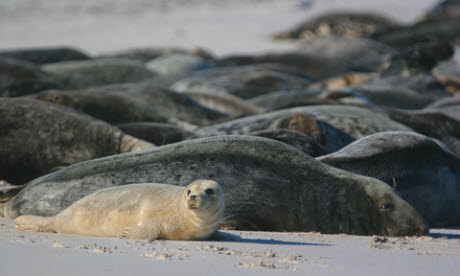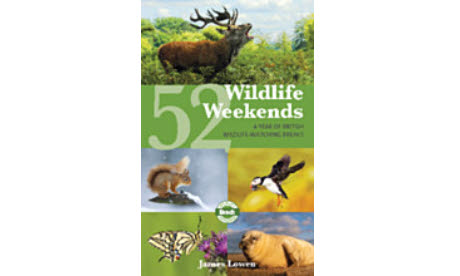
In our final extract from Bradt Travel Guide’s new book 52 Wildlife Weekends, James Lowen shows that the UK has plenty of wildlife-spotting weekends in autumn
From a secluded hollow in coastal sand dunes, disproportionately large and endearingly liquid black eyes smoulder atop the creamiest and fluffiest of marine mammals. ’Love me! Don’t leave me!’, the eyes seem to plead. Not 50m distant, different individuals of the same species engage in a visceral, hormone-fuelled duel. It is hard to imagine two more contrasting dimensions to a single creature in such proximity. Such is the charming paradox of a grey seal colony.
Britain hosts half of the world’s grey seal population, but arguably no group is more breathtaking than Britain’s second-largest breeding colony, at Donna Nook. Here Lincolnshire Wildlife Trust works with the Royal Air Force to manage coastal sand dunes and mudflats for the benefit of all coastal wildlife. Year-on-year there has been an increase in seal numbers... and an explosion in seal-watchers. Some 3,000 seals now breed here, with pups tipping the 1,000 mark. On some weekends, however, there can be even more people visiting!
This mass of mammal creates potential tension between watchers and the watched. Clearly, wildlife welfare must come first. Accordingly, the Trust provides a wardened viewing area in the dunes that enables superb views of seals without disturbing them. To improve prospects of a memorable trip and display consideration to seals and land managers, consider two tactics. First, arrive early in the morning before the crowds descend and while the light is at its purest. Second, visit on weekdays. Whenever you go, sit down, take your time and imbibe. Focus on a small number of individuals and observe their lives for several hours.
Females arrive ashore a day or so before they give birth. The first sign that a newborn has emerged is usually a squabble of gulls scavenging the afterbirth. The pup’s shockingly clotted cream-coloured coat hints at a throwback to the species’ ice-breeding heritage. Youngsters suckle every few hours; the mother’s milk is so rich that newborns double their weight within a week.
Sweep the beach for the hefty, hormonal males. Each has carved out a stretch of the maternity ward along which it reigns as ‘beachmaster’. Cows that pup within a bull’s territory form his harem: mating happens as soon as the females come into season. While neighbourhood relationships are usually placid, evenly matched rivals sometimes spar – and the brutality may turn bloody.
Once you have had your fill of the seal soap opera (or, indeed, the human throng), make for adjacent Saltfleetby–Theddlethorpe. This mouthful of a National Nature Reserve offers several trails along which to explore an 8km tract of coast. Sand dunes form, drift and reform in the wind, with only stabilised structures hosting dense vegetation such as sea buckthorn, hawthorn and elder. November is often characterised by influxes of thrushes from the continent. The orange berries of sea buckthorn refuel blackbirds, fieldfares, redwings and the odd ring ouzel.
Coastwards, saltmarsh cedes to muddy foreshore. Lapland buntings could be anywhere. At Brickyard Lane, tight flocks of twite, sometimes a hundred strong, buzz among the samphire beds. Further out, brent goose, curlew and shelduck forage. At Rimac, the trail crossing maritime fen proffers an outside chance of water shrew. Short-tailed field vole abounds at Churchill Lane, attracting barn owls as dusk whispers its imminence. Finally, check Sea View Washland: who knows what might turn up at these youthful Wildlife Trust scrapes?
Spend the following day wandering leisurely at Gibraltar Point, a National Nature Reserve one hour south at the stand-off between Wolds and Wash. After a cuppa in the visitor centre café, walk south along Rock Ridge to the Wash Estuary viewpoint for harriers, brent geese and, if the tide is high, thousands of roosting knot. As the shorebirds arrive two hours before peak water, they smoke across the sky before eventually pitching down to huddle as a single mass. Movement is kept to a minimum, but every so often, sometimes in response to a peregrine real or imaginary, flock members lift into the air, wings frantically flapping, before eventually returning to their prostrate repose.
For passage migrants, try east along South Beach Road to the bird observatory in the East Dunes. Thrushes scoff sea-buckthorn berries, and you may flush a woodcock or long-eared owl from the dense cover. A black redstart flicks up onto a fence, body bobbing and tail quivering.
After lunch, visit poolside hides either side of the beach car park. A jack snipe, water rail or water pipit may skulk on the margins: not to be sniffed it, even if somewhat less showy than the seals with which you started the weekend.
Where to go: Donna Nook, Saltfleetby–Theddlethorpe Dunes and Gibraltar Point are National Nature Reserves managed in whole or part by Lincolnshire Wildlife Trust: access details and site maps are on both websites. For Donna Nook, leave the A1031 at North Somercotes, driving 4km to Stonebridge. Park sensibly in the small car park; sometimes a local farmer opens a field for overflow parking. From the car park, go the beach and turn right following the dune path to the viewing area. Check the Trust website for current viewing arrangements.
Saltfleetby–Theddlethorpe lies immediately south-east along the coast. Access is via a series of car parks off the A1031. From north to south: Howden’s Pullover; Sea Lane, Saltfleet; Saltfleet Haven (aka Paradise); Seaview; Rimac; Churchill Lane and Brickyard Lane in Theddlethorpe St Helen. There are nature trails at Seaview, Rimac and Churchill Lane. Gibraltar Point is c6km south of Skegness, along Gibraltar Road. Park at the visitor centre or beach car park, 1km nearer Skegness.
Suggested bases: North Somercotes, Theddlethorpe, Mablethorpe and Skegness. A good regional website is www.visitlincolnshire.com. Inland off the A18, The Old Farmhouse offers large, stately rooms and a beamed communal lounge in an 18th-century manor.
Flexibility: Grey seals are present late October to January, but peak November–December. Check the Lincolnshire Wildlife Trust website for updates on numbers. The first half of November is best for passage migrants.
Accessibility: 3
 This weekend escape has been taken from Bradt's 52 Wildlife Weekends: a year of British wildlife-watching breaks (£14.99).
This weekend escape has been taken from Bradt's 52 Wildlife Weekends: a year of British wildlife-watching breaks (£14.99).